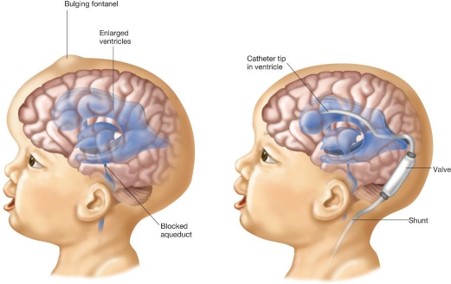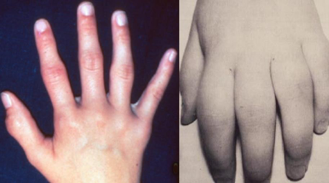When a 2-week-old infant is seen for irritability, poor appetite, and rapid head growth with observable distended scalp veins, the nurse recognizes these signs as indicative of which disorder?
Cerebral palsy
Syndrome of inappropriate antidiuretic hormone (SIADH)
Hydrocephalus
Reye's syndrome
The Correct Answer is C
Hydrocephalus refers to a condition characterized by an abnormal accumulation of cerebrospinal fluid (CSF) within the ventricles of the brain. In infants, hydrocephalus can cause the head to enlarge rapidly as a result of the increased pressure exerted by the accumulating fluid. This is known as "rapid head growth." The increased intracranial pressure canlead to irritability and poor appetite in infants.
The distended scalp veins are another common sign of hydrocephalus. As the fluid accumulates, it puts pressure on theblood vessels in the brain, causing the veins in the scalp to become more visible and distended.
Cerebral palsy in (option A) is incorrect because is a neurological disorder that affects body movement and musclecoordination, but it does not typically present with rapid head growth or distended scalp veins.
Syndrome of inappropriate antidiuretic hormone (SIADH) in (option B) is incorrect because it is a condition characterized by excessive secretion of antidiuretic hormone, leading to fluid imbalance, but it does not usually cause rapid head growth or distended scalp veins. Reye's syndrome (D) is a rare condition that primarily affects the liver and brain, and it does not typically present with rapid head growth or distended scalp veins.
Therefore, based on the signs described, hydrocephalus (C) is the most likely disorder in this case. It is important to seekmedical attention promptly for a proper diagnosis and appropriate management of hydrocephalus in infants.

Nursing Test Bank
Naxlex Comprehensive Predictor Exams
Related Questions
Correct Answer is A
Explanation
The nurse's best response to the student nurse regarding why peer relationships become more important during adolescence is option A. Peer relationships become significant during adolescence because they provide adolescents with a sense of belonging. During this developmental stage, adolescents are transitioning from a primary focus on their family to a greater emphasis on peer interactions and social connections. Peer relationships offer a sense of acceptance, support, and identity as adolescents strive to establish their own identities separate from their families.
adolescents dislike their parents in (option B), is not a correct or comprehensive explanation for the increased importance of peer relationships during adolescence. While it is common for parent-child conflicts to arise during this stage, it does not imply that adolescents dislike their parents as a general rule.
suggesting that adolescents no longer need parental control in (option C), is not correct. While adolescents are seeking increased independence and autonomy, they still require parental guidance and support. Parental control and involvement continue to be essential in providing a secure and nurturing environment during adolescence.
They promote a sense of individuality in adolescents in (option D), is incorrect. Peer relationships do contribute to the development of individuality by allowing adolescents to explore their own interests, values, and social roles. However, the primary reason for the increased importance of peer relationships during adolescence is the sense of belonging and social acceptance they provide.
Correct Answer is B
Explanation
Juvenile arthritis should be suspected in a child who exhibits joint swelling and pain lasting
longer than 6 weeks. Juvenile arthritis refers to a group of chronic inflammatory conditions
that affect the joints in children and adolescents. Persistent joint swelling and pain are
common symptoms of juvenile arthritis and are often accompanied by other signs such as
morning stiffness, limited range of motion, and joint warmth.
, frequent fractures in (option A) is not correct because it, is not typically associated with
juvenile arthritis. Fractures are more commonly associated with conditions affecting bone
strength, such as osteoporosis or certain genetic disorders.
lurching and abnormal gait with limited abduction in (option A) is not correct because it,
may be seen in certain musculoskeletal conditions or hip joint abnormalities, but it is not
specific to juvenile arthritis.
increased joint mobility in (option D) is incorrect because it, is not typically associated with
juvenile arthritis. In fact, joint stiffness and limited range of motion are more characteristic of
this condition.
Whether you are a student looking to ace your exams or a practicing nurse seeking to enhance your expertise , our nursing education contents will empower you with the confidence and competence to make a difference in the lives of patients and become a respected leader in the healthcare field.
Visit Naxlex, invest in your future and unlock endless possibilities with our unparalleled nursing education contents today
Report Wrong Answer on the Current Question
Do you disagree with the answer? If yes, what is your expected answer? Explain.
Kindly be descriptive with the issue you are facing.

